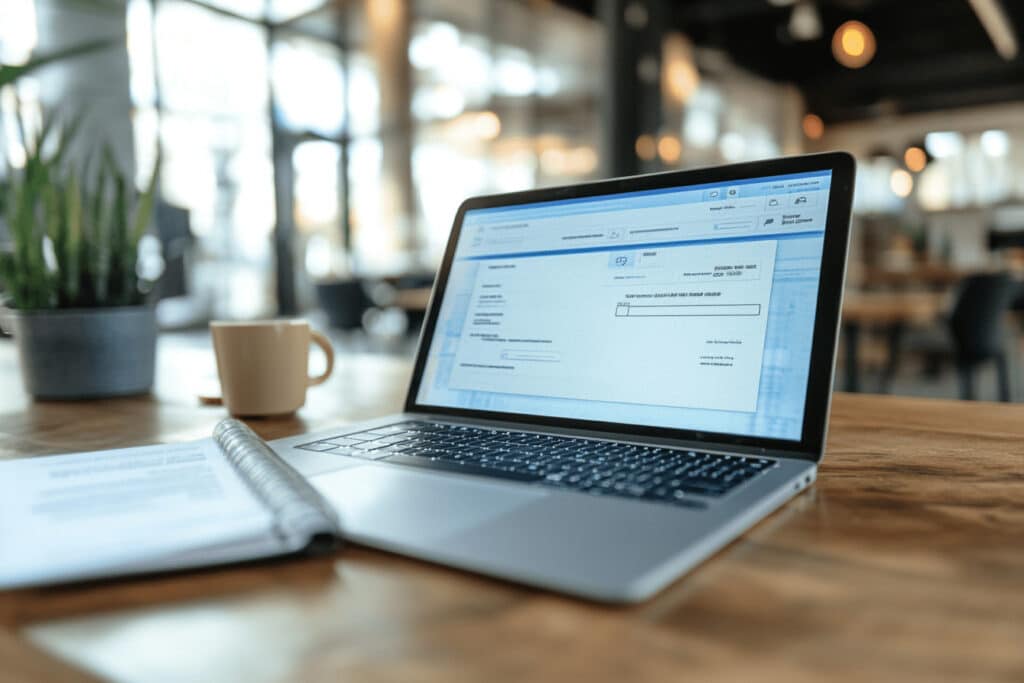In today’s fast-paced digital economy, businesses and consumers alike are seeking secure, efficient, and easy-to-use payment methods. Electronic check processing, commonly known as Echeck processing, offers an innovative solution that combines the reliability of traditional paper checks with the speed and convenience of modern electronic payments.
From reducing processing times to cutting costs, Echecks are becoming an essential part of the payment ecosystem for businesses of all sizes. This article from Payment Nerds provides a basic overview of Echeck processing — what it is, how it works, how it helps your business, and more. Read on and learn the essentials of electronic check processing today!
What is Echeck Payment Processing?
Echeck payment processing involves converting traditional check information — such as the account and routing numbers — into a digital format for seamless electronic transactions[1]. The information is often processed through the Automated Clearing House (ACH) network, a widely used electronic payment system in the United States.
Echeck payment processing allows businesses to handle transactions quickly and securely without manual intervention. Unlike paper checks, which must be physically deposited and processed, Echecks bypass these steps entirely. This accelerates the payment process, minimizes errors, and reduces costs.
Differences Between an Echeck & Other Payment Methods?
Echecks offers unique features that set it apart from other payment methods. Below, we share a list of comparisons between it and other common forms of payment we use:
- Credit Cards: While credit cards are widely accepted, their processing fees are higher because they typically involve a percentage of the transaction amount plus a flat fee. Echecks, on the other hand, have lower flat-rate fees, making them a cost-effective option for large payments.
- Wire Transfers: Wire transfers are faster, often clearing within hours, but come with significantly higher fees than Echecks. For businesses that prioritize cost savings, Echecks strike a balance between affordability and efficiency.
- Paper Checks: Paper checks involve manual handling, which can lead to delays, errors, and increased processing costs. Echecks eliminate these inefficiencies by automating the payment process.
- Digital Wallet: While digital wallets like PayPal and Apple Pay offer convenience, they are often tied to specific platforms or ecosystems. Echecks, on the other hand, are universally compatible, making them a more versatile payment method.
Reasons to Accept Echeck Payments
Echeck payments can be a game-changer for your business. Here’s why:

Lower Costs
ACH transactions involve lower processing fees and other costs than credit card payments, especially for high-value transactions[2]. This makes Echecks an attractive option for industries such as real estate and car sales.
Improved Cash Flow
Echecks process faster than paper checks, reducing the time it takes for funds to become available in your account. This helps improve cash flow management, allowing your business to fund new expansions or produce new products or services.
Convenience for Customers
Echecks offers a straightforward payment process that customers can complete online or over the phone. They make online payments easy, too, allowing customers to pay for goods and services without a credit card.
Broader Payment Options
By offering ACH payments via Echecks, your business can cater to customers who prefer not to use credit cards or digital wallets. This expands your reach and inclusivity and broadens your potential customer base.
How to Start Accepting Echeck Payments
Implementing Echeck payments in your business is a straightforward process. Here’s a step-by-step breakdown of how to start Echeck payment processing[3]:
- Set Up An ACH Merchant Account
The first step is to partner with a payment processor that supports ACH transactions like Payment Nerds. This processor will provide the tools and resources needed to handle Echeck payments securely and efficiently. - Authorize the Customer
To begin processing an Echeck, you must obtain explicit authorization from the customer. This can be done via a signed agreement, online consent form, or recorded phone call. - Input Payment Details
Enter the customer’s account and routing numbers into your payment system. Double-check this information to avoid errors that could delay the transaction. - Send Details to Your Payment Processor
Once the payment information is collected, it’s sent to your payment processor, who will initiate the transaction through the ACH network. - Confirm You Received Funds
After the payment clears, typically within 3-5 business days, verify that the funds have been deposited into your merchant account. Notify the customer once the transaction is complete.
It’s fast and easy, especially if you work with a payment processor that provides tailored solutions, like Payment Nerds. We ensure your business can easily accept Echeck payments, other electronic payment methods, invoices, and recurring payments. Supercharge your business with our payment solutions today!
How Does Electronic Check Payment Processing Work?
Electronic check processing is a multi-step process designed to ensure secure, efficient, and accurate payment transfers. Each step is crucial in moving funds from the customer’s account to the merchant’s account. Let’s break it down in detail:
1) The Customer Authorizes a Transaction
The process begins with the customer providing authorization for the payment. This step is essential to comply with financial regulations and to ensure the transaction is legitimate. Authorization can take several forms:
- Online Form: The customer fills out an online form with their bank account and routing number, along with a checkbox or e-signature agreeing to the payment terms.
- Verbal Consent: For phone-based transactions, the customer can provide verbal authorization, often recorded for verification purposes.
- Signed Agreement: Businesses may require a signed agreement detailing the terms of payment for recurring payments, such as subscriptions.
At this stage, businesses should ensure their systems securely capture and store the customer’s banking details, adhering to Payment Card Industry Data Security Standard (PCI-DSS) compliance and other relevant security standards.
2) Funds Transfer Through the ACH Network
Once authorization is obtained, the payment processor initiates the transaction through the Automated Clearing House (ACH) network. The ACH network acts as an intermediary, facilitating the transfer of funds between the customer’s and merchant’s banks.
ACH transactions are typically processed in batches rather than individually, which helps keep costs low. Payments are grouped together based on their submission time and sent for clearing.
The ACH network verifies the validity of the account details provided, ensuring no errors or mismatches. If an issue is detected, the payment is flagged, and the transaction does not proceed. If the transaction passes verification, the ACH network initiates the fund transfer.
This step is efficient but not instantaneous, as ACH transfers are typically completed within 1-3 business days. Same-day ACH processing is sometimes available, though it may come with higher fees.
3) Funds Reach the Merchant’s Bank Account
After the ACH network processes the payment, the funds are deposited into the merchant’s account. At this stage, the merchant receives a notification of the deposit, allowing them to confirm the payment has been successfully completed.
Some businesses may experience slight delays if the transaction is flagged for further review by the payment processor. A common reason for delays is that the name on the customer’s account does not match the name provided during authorization. Large or unusual transactions may also require additional verification.
4) The Business Moves Funds from the Merchant Account
Once the funds are deposited into the merchant’s account, the business can transfer them to their official business bank account for operational use. This may include paying vendors, covering payroll, or reinvesting in business activities.
This final step provides the predictability needed to maintain consistent cash flow for businesses that rely on recurring payments. Additionally, since Echecks offers lower processing fees than credit cards, businesses retain a larger portion of their revenue.
Common Questions & Challenges About E-Check Processing
Echeck processing is a practical and efficient payment solution, but many businesses and customers have questions about how it works and what challenges they might encounter. Below, we address some common concerns:
What is a recognizable way people use electronic check processing?
Echecks are widely used in industries that rely on recurring payments or large transactions. Some common examples to follow include:
- Utility Bills: Customers often pay water, electricity, or gas bills via Echecks.
- Rent Payments: Landlords and property management companies use Echecks to collect rent efficiently.
- Subscription Services: Gyms, magazines, and other subscription-based businesses benefit from the recurring payment capabilities of Echecks.
- B2B Transactions: Businesses frequently use Echecks for high-value transactions, such as vendor and supplier payments. To enhance this functional capability, rely on a payment processor that provides custom billing solutions like Payment Nerds.

How fast are Echeck payments & Echeck payment processing?
Echecks aren’t instantaneous, but they are significantly faster than traditional paper checks. Standard electronic check processing should take between three to five business days. However, they can be processed within one to two business days for a higher processing fee.
Overall, speed depends on the payment processor, the banks involved, and whether the transaction is submitted during business hours or over a weekend.

Is Echeck a safe way to make payments?
Yes, Echecks are highly secure, thanks to the multiple layers of protection embedded in most electronic funds transfer systems, like the ACH network. These systems often provide advanced encryption methods to protect customer data from being stolen, as well as thorough authentication systems to ensure all parties are verified to accept and pay with an Echeck. These thorough security measures make Echecks one of the safest ways to process payments.
What do I need to be able to send an Echeck?
To send an Echeck, customers or businesses need the following:
- Bank Account Information: The payer’s account number and routing number.
- Authorization: Explicit permission from the account holder to initiate the payment.
- Access to a Payment Processor: A reliable processor that supports Echeck payments.
For businesses, having an ACH merchant account is essential for processing Echeck transactions.
Are there signs of potential fraudulent Echeck payments?
Fraud is always a concern, but recognizing red flags can help businesses mitigate risks. Here are a few to remember:
- Mismatched Information: Details such as the account holder’s name or address don’t match the payment information.
- Large, Unusual Transactions: A significant payment amount that deviates from typical customer behavior.
- Repeated Failures: Multiple failed attempts to process a payment from the same account.

Using a payment processor with robust fraud detection tools is essential for identifying and preventing fraudulent Echeck transactions. That’s why we at Payment Nerds provide thorough fraud prevention services, ensuring your business avoids the risk of digital payment methods while enjoying their full benefits.
Conclusion
Electronic check processing is a reliable, secure, and cost-effective way for businesses to accept payments. By leveraging the ACH network, Echecks simplify transactions, reduce costs, and improve cash flow. Whether you’re handling large transactions, recurring payments, or expanding your payment options, Echecks are an excellent choice for modern businesses.
Ready to embrace the benefits of Echeck processing? With Payment Nerds, you can set up electronic check processing for your business. Let us help you transform your enterprise business through this efficient payment method.
Sources
- Bureau of the Fiscal Service. “Electronic Check Processing.” https://fiscal.treasury.gov/ecp/ Accessed December 6, 2024.
- Investopedia. “Electronic Check (E-Check): Definition and How It Works.” https://www.investopedia.com/terms/e/electroniccheck.asp Accessed December 6, 2024.
- Quickbooks. “What is an eCheck? Understanding how electronic checks work and how to accept payments.” https://quickbooks.intuit.com/r/payments/what-is-an-echeck/ Accessed December 6, 2024.


